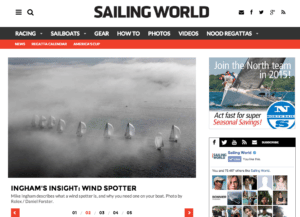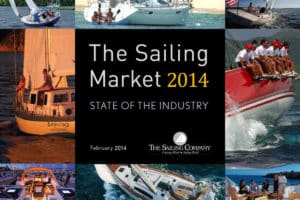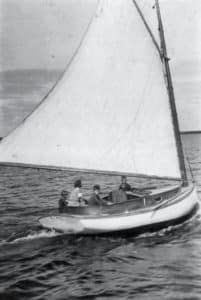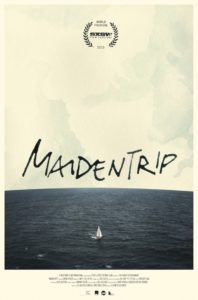Ryan O’Grady, a veteran follower of the Volvo Ocean Race and a top amateur sailor, is providing regular insight and analysis on the 2011-’12 Volvo Ocean Race for SailingWorld.com. To get the full picture of this dynamic race, follow the racing in our Finish Line forum, track the fleet, and catch up on the race with O’Grady’s previous Volvo Voyeur blogs.
Leg 1 of the Volvo Ocean Race is in the books. Team Telefonica won the battle of attrition in a not-so-blistering time of 21 days, 5 hours, followed by CAMPER/ Emirates Team New Zealand, and Groupama. Abu Dhabi Ocean Racing and Team Sanya returned to Alicante, Spain within 24 hours of the start—the former due to dismasting, the latter to hull damage—and PUMA Ocean Racing retired after dismasting on Nov. 21 in the middle of the South Atlantic, 2,000 miles from Cape Town. Abu Dhabi and Team Sanya are on pace to make the in-port race in Cape Town on Dec. 10. The Puma crew and mar mostro are currently aboard a container ship from Tristan de Cunha to Cape Town.
So what have we, the armchair sailors of the world, learned during these past few weeks?
The Online Gamers Can Beat Some of the Pros:
The winning time for Leg 1 of the Volvo Ocean Race Game belongs to a French player with the screen name Kangoo I. Had they been sailing in the actual race, Kangoo I’s time of 22 days, 1 hour would’ve been good enough for a third-place finish, ahead of Groupama (and the retirees). As a reward, race organizers will fly Kangoo I to Abu Dhabi to celebrate New Years at the stopover prior to Leg 3. Hopefully, Kangoo I’s flight has Internet access; otherwise their winning streak will likely come to an end. To stay ahead in the race race—online or on the water—takes constant attention.
**
CAMPER/ Emirates Team New Zealand Is the Black Sheep**
The Kiwi team has faced persistent criticism from fellow competitors over the setup of their forestay. Puma Ocean Racing and Abu Dhabi Ocean Racing were the first to protest, on Oct. 1, followed by Telefonica a day later, and by Groupama on Oct. 29, after the first in port race. At issue is whether CAMPER’s headstay can be adjusted while underway, which would illegal according to the current Volvo 70 rule. While all protests have so far been dismissed, Groupama again protested following Leg 1, claiming that CAMPER’s mast:
• Does not positively lock its means of adjustment of the forward support of the mast
• Take tension on the forestay when using a strop on an articulated forestay
• Steady the mast when using the strop on an articulated forestay
• Does not have a permanent forestay—a permanent rake—a circular standing rigging
• Has two elements of the standing rigging near parallel. Uses a device similar to a “headfoil”—a device to adjust the standing rigging for measuring standing rigging tension.
In response to yet another protest, CAMPER skipper Chris Nicholson said, “We are still awaiting full details, but we’re disappointed that this action has been taken, as we feel this issue has already been addressed in a full and final manner first by the arbitration panel and then by the international jury.”
**
Don’t Stray From the Pack**
While big separations in the fleet make for compelling viewing, they rarely pay off for competitors in the long term. No one knows this better then the boys on Groupama, who coasted into Cape Town in a distant third on Nov. 29. While discussing the team’s struggles, bowman Brad Marsh said, “[It was like] trying to suck a cabbage through a cocktail straw. It was an intense mental battle. It was very difficult not having the other boats around.”
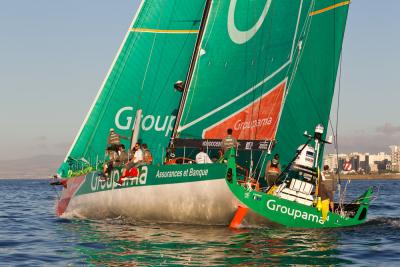
IAN ROMAN/Volvo Ocean Race
_Groupama finishes Leg 1; they might think twice about splitting with the fleet in the future.
_
While Franck Cammas might know his way around the Atlantic highs better than most, the fact remains that this is a race, not a record attempt. In a record attempt, you can take a risk early, and if it doesn’t pay, you go home and try again. In a race like the Volvo, though, getting into a different pattern of weather systems can ruin all of your best efforts. While it’s true that in the 2008-’09 VOR, Ericsson 3 made a bold move in the Southern Ocean to win Leg 5 from Qingdao, China to Rio de Janeiro, Brazil, historically speaking, splitting with the fleet is unsuccessful. In the case of Ericsson 3, the odds of success were greater since they were in an area of the world with typically strong and consistent breeze. Groupama’s rolling of the dice on Leg 1, in which competitors had to negotiate two major high-pressure systems and the Doldrums, was a high-risk move. CAMPER was wise to realize the mistake of following Groupama; they cut their losses early to get back with the pack. I’m guessing both teams will be less likely to stray from the pack again.
**It’s Better to Have Bad Luck Near Shore
**Both Puma and Abu Dhabi Ocean Racing were feeling quite confident heading into Leg 1, and for good reason. Both teams are well financed, well staffed, and both had the luxury of plenty of practice time. Over the summer, Puma won the Transatlantic Race, and Abu Dhabi won the Fastnet Race. Both teams came to the starting line as frontrunners.
Ian Walker’s Abu Dhabi team was the first to fall, breaking the mast only a few hours into the race in horrendous seas. That mast was one of the first produced by Future Fibres, a company previously known as a composite rigging specialist. Prior to the race, Walker marveled at the new spar. “I think the rig’s awesome,” he said. “It’s every bit as clean and neat as I could’ve hoped. The locks and fittings are working really well. It’s the early days of course, but thus far I’d say this is the best rig I’ve ever seen. The attention to detail, the windage reductions, the cleanness of the rigging in terms of spreader ends and aerodynamics, it really is impressive.”
While those superlatives may have been premature, Abu Dhabi’s rig is impressive. Scott Ferguson, the man behind such projects as the wing spar for BMW Oracle’s USA 17, led much of its engineering. The silver lining to Abu Dhabi’s bad luck is the fact that the failure occurred close to their shore team and their spare mast, which were in Lisbon at the time. Had it not been for a windless patch of ocean over 500 miles wide, Abu Dhabi could’ve returned to finish the leg. Instead, the team took the safe option and loaded the Azzam onto a ship and carried out a series of upgrades and modifications to their new mast.
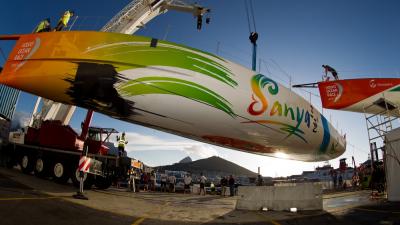
IAN ROMAN/Volvo Ocean Race_
Team Sanya arrives in Cape Town after retiring from Leg 1 due to severe hull damage. _
Shortly after Azzam‘s dismasting, Moose Sanderson and Team Sanya launched off a wave and fractured the boat’s hull—apparently on some underwater floating object. The boat nearly sank, but the team managed to get it to Lisbon to join the growing shipping armada bound for Cape Town. Again, being close to a port saved the day for Team Sanya. Had the failure happened thousands of miles out in the open sea, the situation could’ve been much, much worse.
Kenny Read must now that feeling all too well, as he and the rest of Puma Ocean Racing are en route from Tristan da Cunha, where they diverted after their Hall Spars mast failed in the middle of the South Atlantic while battling Telefonica for the lead. The Puma rig is an evolution of the mast used by both Telefonica teams in the last race, and the cause of its failure remains a mystery. While Ian Walker and the Future Fibres team have now had the time to do a proper engineering analysis on the failure, the Hall team won’t actually get to see the broken bits firsthand until days before the start of Leg 2. Hopefully, photos and video from the boat can provide enough data to inspire confidence in the ability of mar mastro’s new rig to survive the rigors of the rest of the race.
**To Finish First, First You Need to Finish
**We’ve all heard the age-old sailor’s adage, but is it really true for the Volvo Ocean Race? In the old days, when the race was scored solely on elapsed time, Puma and Team Sanya would surely be out. Abu Dhabi would’ve elected to finish Leg 1, but it would’ve been nearly impossible to make up the amount of time owed. Today, however, is a different world. Each offshore leg is worth a maximum of 30 points, with total points dropping by 5 points for each successive finishing position. In-port races are worth a maximum of 6 points, decreasing by 1 point for each successive position. As it stands now, the scoreboard is:
- Team Telefonica- 31 points
- CAMPER/ ETNZ- 29
- Groupama- 22
- Abu Dhabi Ocean Racing- 6
- Puma Ocean Racing by BERG- 5
- Team Sanya- 3
With eight offshore legs left, and nine in-port races, there are a total of 49 points in swing, assuming any of the bottom three teams can consistently beat Team Telefonica. Any team can still mathematically win, provided all six teams start in Cape Town and finish each leg. That’s a big assumption, considering the rate of attrition so far. The good news is that the race isn’t over yet, and the hometown team I’m rooting for—Puma Ocean Racing—still has a shot to win it all. Kenny and the boys will need to sail well—and catch a few good breaks—to make that happen.

